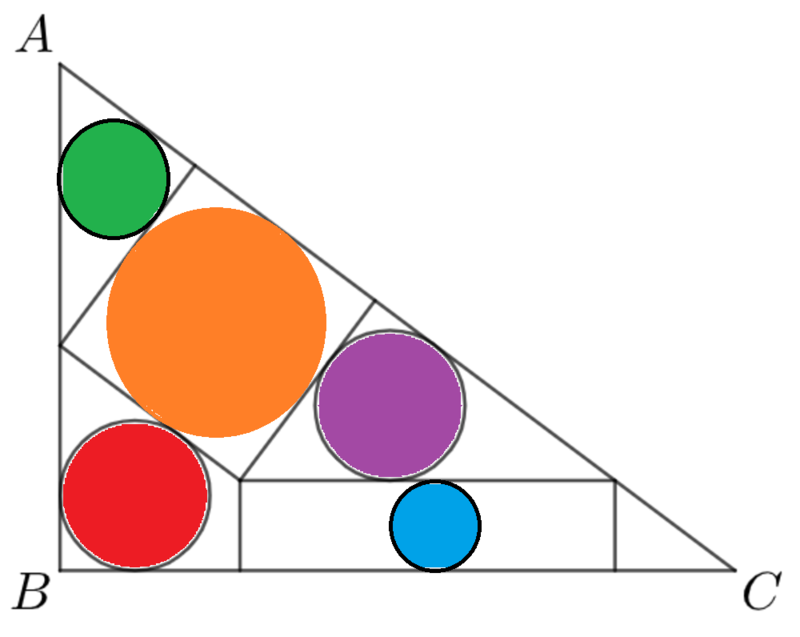A sequel to the Odd Sangaku problem by Michael Huang.

In the right triangle ABC having side lengths:
AB = 27 and BC = 36
The square and the rectangle are positioned inside this triangle, such that the purple and red circles have the same radii.
Input the sum of the squares of the radii of all five circles as your answer.
The answer is 82.76.
This section requires Javascript.
You are seeing this because something didn't load right. We suggest you, (a) try
refreshing the page, (b) enabling javascript if it is disabled on your browser and,
finally, (c)
loading the
non-javascript version of this page
. We're sorry about the hassle.
Label the diagram as follows, add segments H F and F K , and let x = D E = E F = F G = G D .
By the Pythagorean Theorem on △ A B C , A C = 2 7 2 + 3 6 2 = 4 5 .
All the triangles are similar to each other by AA similarity, and since the purple and red circles have the same radii, △ E B K ≅ △ F G I , so E B = x .
Since △ A B C ∼ △ A D E , A E = E D ⋅ B C A C = x ⋅ 3 6 4 5 = 4 5 x and A D = E D ⋅ B C A B = x ⋅ 3 6 2 7 = 4 3 x
Then A B = A E + E B = 4 5 x + x = 2 7 , which solves to x = 1 2 .
That means the radius of the orange circle is r o = 2 1 ⋅ 1 2 = 6 .
It also means that A E = 4 5 x = 4 5 ⋅ 1 2 = 1 5 , and A D = 4 3 x = 4 3 ⋅ 1 2 = 9 , so the radius of the green circle is r g = 2 1 ( 1 2 + 9 − 1 5 ) = 3 .
From △ F G I ∼ A D E , the purple incircle is A D F G = 9 1 2 = 3 4 bigger than the green incircle, so the purple circle has a radius of r p = 3 4 r g = 3 4 ⋅ 3 = 4 .
The red circle has the same radii as the purple circle, so r r = r p = 4 .
Since △ E H F ∼ △ A B C , E H = E F ⋅ A C A B = 1 2 ⋅ 4 5 2 7 = 5 3 6 .
Then H B = E B − E H = 1 2 − 5 3 6 = 5 2 4 , so the radius of the blue circle is r b = 2 1 ⋅ 5 2 4 = 5 1 2 .
Therefore, the sum of the squares of the five radii is r o 2 + r g 2 + r p 2 + r r 2 + r b 2 = 6 2 + 3 2 + 4 2 + 4 2 + 5 2 1 2 2 = 8 2 . 7 6 .